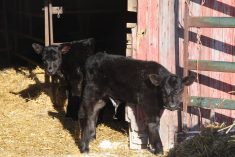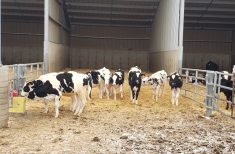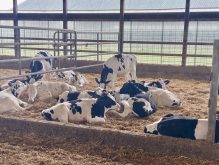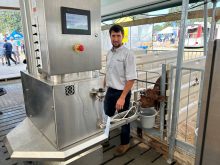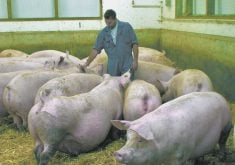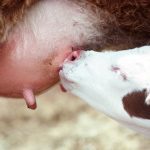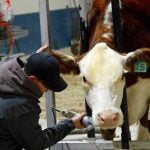The first two months of a heifer’s life are critical for laying the foundation for her long-term health and productivity.
Recent research on epigenetics and perinatal programming of young dairy calves has solidified a connection between early health and long-term milk production impacts, Elad Ben-Ezra, DVM-MBA and Zoetis veterinary service manager (cattle) told attendees at the virtual dairy day during Grey Bruce Farmers Week.
Why it matters: Studies have shown a direct link between the growth rates during the first few months of life and three factors that impact milk production: age at first calving, milk production in the first and second lactation, and longevity within the herd.
Read Also

Jennifer Hayes appointed for second term as the Chairperson of the Canadian Dairy Commission
Jennifer Hayes has been re-appointed as Chairperson of the Canadian Dairy Commission by Heath MacDonald, Minister of Agriculture and Agri-Food.
“The concept of epigenetics is that there’s a critical period in this calf’s life, specifically in those first two months, the first 60 days,” said Ben-Ezra. “Things like colostrum, her early growth rate, her health – or on the flip side if she has any illnesses like a respiratory disease – all of these can influence the expression of this calf’s genes later in life.”
“If we’re able to keep calves healthy and growing well during this critical time, we can have a really positive impact on these three important outcomes,” he said.
Ben-Ezra pointed to studies released by the Journal of Dairy Science showing a correlation between a higher average daily gain of a young heifer calf and higher milk production on her first lactations.
“This is a really powerful finding,” he said. “All things being equal, we can increase a heifer’s milk production by how we manage her, how we feed her and how we protect her from diseases as a very young calf.”
Calves are born without protective levels of antibodies, and their immune system is slow to fully mature, which is why providing passive maternal antibody transfer through colostrum within the first two hours and eight hours of life is critical.
To increase the dam’s passive antibodies through colostrum, some vets encourage a vaccination protocol for scours five weeks before birth to create a “scour guard” of sorts for the calf when it ingests the fortified colostrum, he said.
Additionally, farmers can promote ideal health in calves by focusing on the five Q’s of colostrum: Quickly, Quality, Quantity, sQueaky clean and Quantify and providing optimal quality and quantity of nutrition, free access to clean water, a clean, dry and comfortable resting area and adequate draft-free ventilation.
The three immediate aspects of fortifying a calf’s immune system begin from the first few minutes of life onward. First, the colostrum plays a critical role in transferring passive immunity and impacts the calf’s long-term production in her first and second lactation. Administering the full complement of colostrum within the first 12 hours increases the calf’s ability to absorb maternal antibodies because, after that, it declines rapidly and stops after 24 hours.
“Studies have shown that four litres (in the first two hours of life) followed by two litres really will result in better passive transfer for your calves,” said Ben-Ezra. “If they’re not going to drink the full allotment, it is best to tube them. So, it is best to get that four litres in. . . then following up with colostrum at eight or 12 hours.”
Colostrum collected from healthy, clean-uddered cows within two hours of birth ensures optimal quality. It should have a 22 per cent or better antibody reading on a Brix refractometer or green on a colostrometer. In addition, Ben-Ezra said it should be free of debris, blood and other contaminants because high bacteria levels can block the absorption of maternal antibodies.
By following the time and quantity guidelines for colostrum administration, treatment rates and mortality rates could decline while growth rates and feed conversion could improve. Ben-Ezra said first calving would occur at a younger age and first and second lactation would have increased milking production.
Feed colostrum at 10 per cent of a calf’s body weight, but increase milk or milk replacers to 20 per cent of body weight, or five to 6.5 litres for every 50 kilograms to reach a daily growth of 600 grams a day.
“The immune system runs on glucose, and if we aren’t providing calves with enough calories, they just aren’t able to mount a good immune response when challenged by pathogens in their environment,” Ben-Ezra said.
A vet-administered blood test to measure the protein levels will assess how successful passive transfer was with a goal of 85 to 90 per cent of calves showing optimal results.
“You can’t fake this part of the assessment; the calves will just tell you how you are doing in the program,” he said
Calves are most at risk from Bovine Respiratory Disease (BRD) and scours in the first two months, with the latter impacting one-in-four calves less than 20 days old and accounting for 56 per cent of pre-weaned dairy calf deaths.
A 2014 study found 22 per cent of the 3,000 calves up to three months old from 20 dairies across Ontario and Minnesota were treated for pneumonia, with a 2019 California study of 11,000 dairy calves mirroring the results.
A 2018 study of lung consolidation, a sign of BRD lung damage, in young heifer calves found 57 per cent had some degree of impact in the first eight weeks of life, even without clinical disease symptoms. This damage could result in a 525 kg decrease in first lactation milk production.
“That’s a huge amount. This study really highlighted that BRD rates may be higher than expected, just based on treatments and that it has a real impact in terms of future milk production,” said Ben-Ezra, adding up to 70 per cent of calves might be exposed to BRSV in the first year before breeding.
There are vaccines available to protect the calf; however, individual calf timelines in which the maternal antibodies interfere and block the efficacy of immunization are fluid, said Ben-Ezra.
To negotiate a work-around for that interference, Zoetis developed INFORCE 3, an intranasal vaccine able to be administered to the nostrils of calves as young as three days old and provide a level of BRSV immunity, regardless of maternal antibody levels.
“When we’re talking about vaccination, that’s defined simply as the act of giving a vaccine. The end goal, however, is that we’re trying to properly immunize that animal,” Ben-Ezra said.
A recent study of 15 control and 15 INFORCE 3 vaccinated calves showed significantly lower lung damage and a 70 per cent decrease in mortality for vaccinated calves.
“If we keep our heifers as healthy as possible and eliminate that occurrence of BRD, then we know the opposite is true,” he said. “We’re having a real positive impact on that future milk production.”




